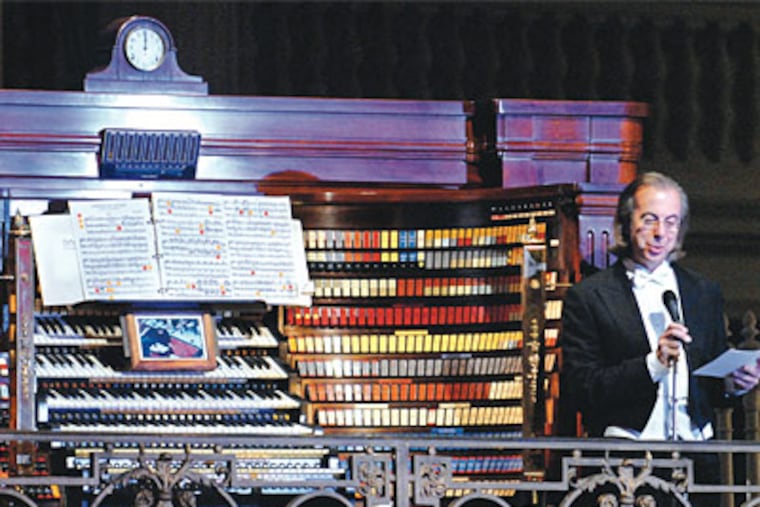Pulling out all the stops
Wanamaker Organ, Philadelphia Orchestra team up, 80 years late.

"You're about to experience history in the making."
That strong statement from organist Peter Richard Conte had no apparent argument from the 1,200-strong audience last night when the Philadelphia Orchestra and Wanamaker Organ, recently restored at its longtime home in the Center City Macy's department store, finally kept their oft-broken date.
Their joint concert was dominated by Symphonie Concertante, a work written for both orchestra and organ in 1926 by the great Belgian composer/organist Joseph Jongen, but whose premiere was postponed and eventually cancelled by a succession of circumstances, among them the 1929 stock market crash and ensuing Great Depression.
Current parallels to those years weren't about to dampen Macy's ongoing 150th anniversary, of which the Philadelphia concert - and restoration of the 28,482-pipes organ, and said to be the largest currently functioning instrument in the world - is among the high-profile events. As part of the celebration, Macy's commissioned Lord of the Rings film-music composer Howard Shore to write Fanfare, premiered last night with the composer in attendance.
Mayor Nutter arrived late and left before the concert closed with "Happy Birthday" (to Macy's) with New Year's Eve-style ribbons falling from the ceiling of the Grand Court, where the audience was nestled between glass cases of women's jewelry, with racks of handbags to the west and high-heeled boots to the east.
The organ's grand edifice of pipes overlooking the audience (topped by a gold angel blowing two trumpets) was bathed in colored lights for different pieces - green for "Happy Birthday," lavender during Elgar's Pomp and Circumstance and blue for Jongen. All seats were filled, though how much the concert grossed for the Friends of the Wanamaker Organ (with benefit-priced tickets between $100 and $5,000) remained to be seen.
The Philadelphia Orchestra was never a frequent visitor to the then-Wanamaker's Department Store during the 1910s and '20s, and it is not difficult to imagine why. Built for the 1904 St. Louis World's Fair, installed in Philadelphia in 1911, the instrument was expanded to engulf the cathedral-like spaciousness of Wanamaker's Grand Court during free daily lunch and evening concerts - with a reverberation that makes sound linger for an estimated five seconds.
Coordinating (and not overwhelming) any guest ensemble, even the Philadelphia Orchestra under associate conductor Rossen Milanov, is bound to be tricky. And though there were no audible mishaps amid some sensitive decisions on the part of organist Conte, listeners hoping for a revelation upon hearing Jongen performed by the forces for which it was written might have felt shortchanged. Though Jongen's Symphonie Concertante earned a fine reputation in worldwide concert halls despite its aborted 1928 Philadelphia premiere, the Macy's venue, at least on Saturday, was one in which a good 30 percent of the piece was lost in huge washes of sound.
Other historic bases touched upon by the program included Bach's Toccata and Fugue as famously transcribed for organ and orchestra by the Philadelphia Orchestra's first great music director, Leopold Stokowski. Cortege and Litany for Organ and Orchestra was the work of organist/composer Marcel Dupre, a key consultant when the organ was expanded in the 1920s into the world's grandest instrument.
The new Fanfare by Shore came out of protracted, intense study of the organ's possibilities: Though Shore is said to have intended an hour's visit to Macy's to hear what he was writing for, he stayed for at least four. The 10-minute piece seemed out to explore as many possibilities as possible, perhaps at the expense of writing a coherent piece, with brass writing encompassing suggestions of Wagner's Die Meistersinger as well as John Williams' Star Wars.